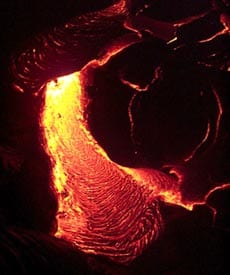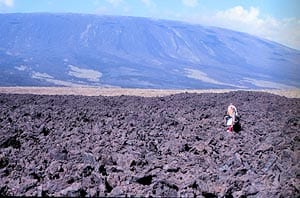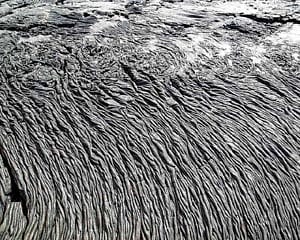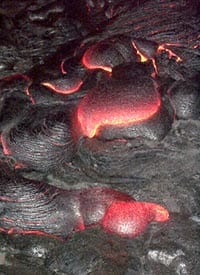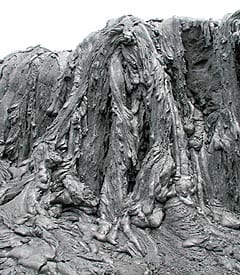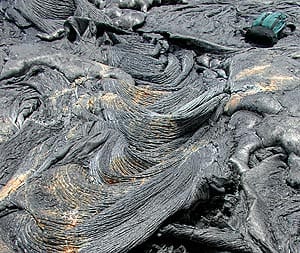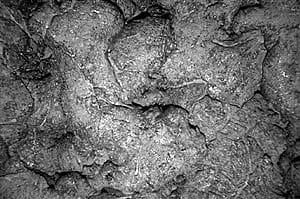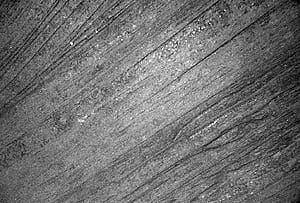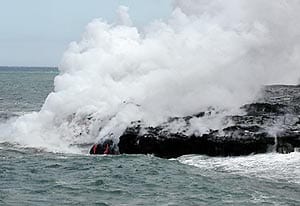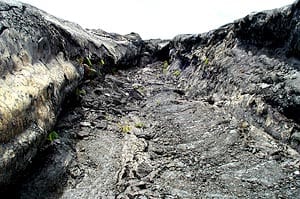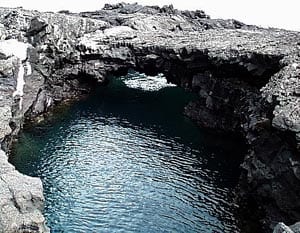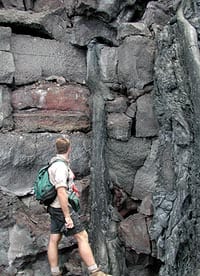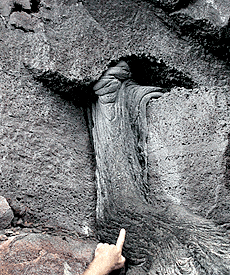Lava Slideshow
- Lava flowing at night during from the Pu’u Oo eruption on Kilauea volcano Hawaii in April, 2000. Scale across photo is about 1 meter. (Photo by Bruce Applegate, HMRG.)
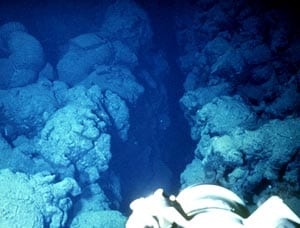 Submarine pillow flows along an eruptive fissure near the crest of the East Pacific Rise at 2600 meters depth. Scale across photo is about 4 meters. Camera across the foreground is one of Alvin’s video cameras. (Photo by Dan Fornari, Woods Hole Oceanographic Institution)
Submarine pillow flows along an eruptive fissure near the crest of the East Pacific Rise at 2600 meters depth. Scale across photo is about 4 meters. Camera across the foreground is one of Alvin’s video cameras. (Photo by Dan Fornari, Woods Hole Oceanographic Institution)- A’a lava field on Fernandina, Galápagos, on the northwest coastline. Walking across a flow like this can be an extremely painful experience. Note the ‘tortoise-shell’ profile of the volcano’s summit in the background. (Photo by Mark Kurz, WHOI)
- Ropy pahoehoe lava on Santiago Island, Galápagos. (Photo by Bob Reynolds)
- Pahoehoe toes forming in the active part of the Pu’u Oo flow, Kilauea volcano Hawaii in April, 2000. Scale across photo is about 2 meters. (Photo by Bruce Applegate, HMRG)
- Pahoehoe flows cascading over a small scarp near the ocean entry of the Pu’u Oo flow, Kilauea volcano Hawaii in June, 2001. Scale from top to bottom of scarp is about 4 meters. (Photo by Dan Fornari, Woods Hole Oceanographic Institution)
- Pahoehoe lava transitioning into ropy pahoehoe (at left of photograph) on Kilauea volcano, Hawaii. Daypack at upper right for scale. (Photo by Dan Fornari, Woods Hole Oceanographic Institution)
- Submarine lobate flow on the East Pacific Rise crest at 2500 m depth. Scale across image is ~3 meters. (Photo by Dan Fornari, Woods Hole Oceanographic Institution)
- Submarine sheet flow on the East Pacific Rise crest at 2500 m depth. Scale across image is ~3 meters. (Woods Hole Oceanographic Institution)
- Ocean entry of the Pu’u Oo flow, Kilauea volcano Hawaii in June, 2001. Note the two small rivulets of lava cascading down the face of the flow just above the water line in the center-left of the frame. Distance across the photo is about 20 meters. (Woods Hole Oceanographic Institution)
- Lava channel on Kilauea volcano, Hawaii. Scale across the channel is about 5 meters. (Photo by Dan Fornari, Woods Hole Oceanographic Institution)
- Lava tube at the coastline on Santiago Island, Galápagos. Distance across the tube is about 6 meters. (Photo by Bob Reynolds)
- Greg Kurras, a student at U. Hawaii, SOEST, standing at the beach cliff at the shoreline where the Pu’u Oo eruption was entering the sea in June, 2001. Note the layers of lava, each about 1 meter thick. Note also the narrow flow that has cascaded down from a small tube in one of the flows at the top of the photograph. The next photo shows a close up of this small lava tube. Scale from top to bottom of image is about 5 meters. (Photo by Dan Fornari, Woods Hole Oceanographic Institution)
- A finger pointing to the lava flow that has traveled through the small lava tube in the cliff face. Scale across photo is about 1 meter. (Photo by Dan Fornari, Woods Hole Oceanographic Institution)
Image and Visual Licensing
WHOI copyright digital assets (stills and video) contained on this website can be licensed for non-commercial use upon request and approval. Please contact WHOI Digital Assets at images@whoi.edu or (508) 289-2647.

